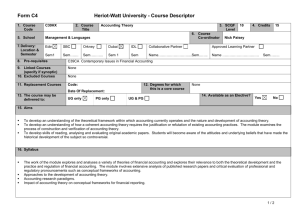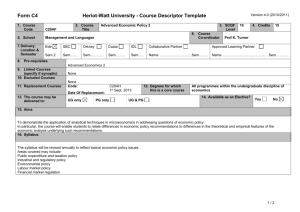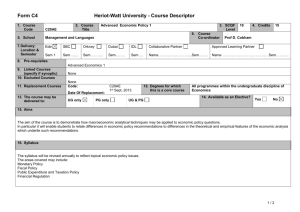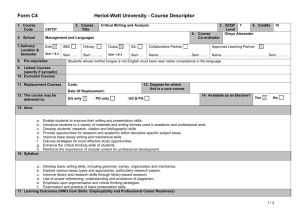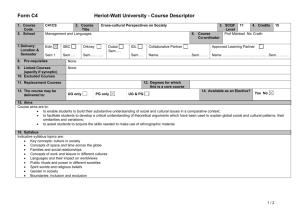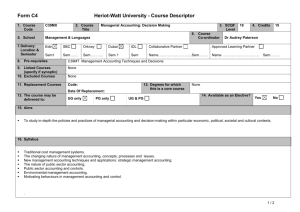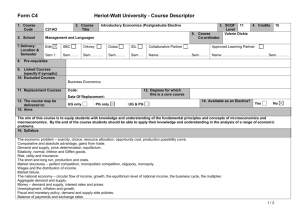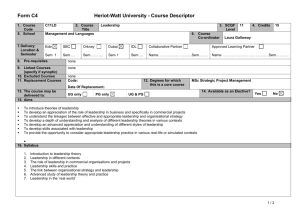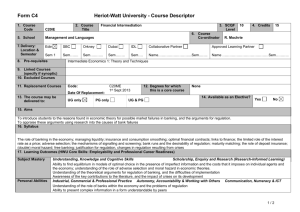2015-06-19 Festival of Education (LALPAD)
advertisement
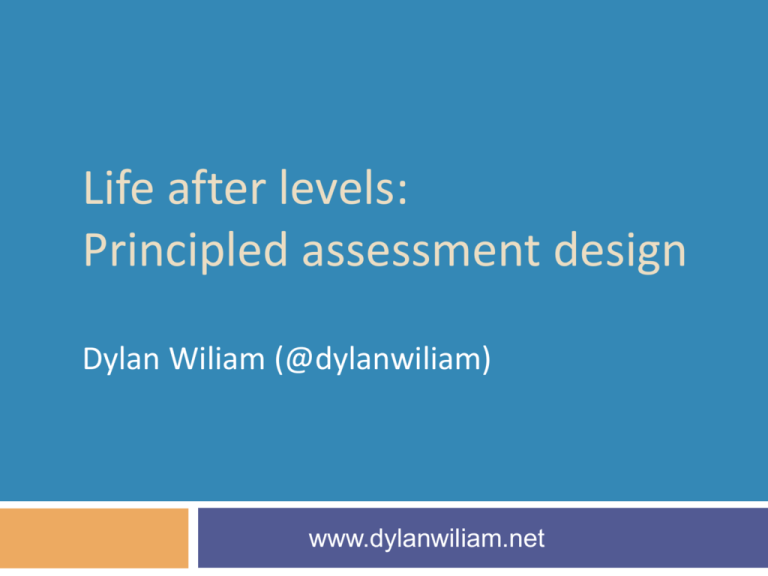
Life after levels: Principled assessment design Dylan Wiliam (@dylanwiliam) www.dylanwiliam.net Initial assumptions 2 The assessment system should be designed to assess the school’s curriculum rather than having to design the curriculum to fit the school’s assessment system. Since each school’s curriculum should be designed to meet local needs, there cannot be a one-size-fits-all assessment system—each school’s assessment system will be different. There are, however, a number of principles that should govern the design of assessment systems, and There is some science here—knowledge that people need in order to avoid doing things that are just wrong. Outline 3 Assessment (and what makes it good) Designing assessment systems Recording and reporting Before we can assess… 4 The ‘backward design’ of an education system Where ‘Big do we want our students to get to? ideas’ What are the ways they can get there? Learning When progressions should we check on/report progress? Inherent and useful checkpoints Big ideas 5 A “big idea” helps make sense of apparently unrelated phenomena is generative in that is can be applied in new areas Some big ideas of the school curriculum 6 Subject Big idea English The “hero’s journey” as a useful framework for understanding myths and legends. Geography Patterns of human development are influenced by, and in turn influence, physical features of the environment. History Sources are products of their time, but knowing the circumstances of their creation helps resolve conflicts. Mathematics Fractions, decimals, percents and ratios are ways of expressing numbers that can be represented as points on a number line. Science All matter is made of very small particles Sociology The way people behave is the result of interplay between who they are (agency) and where they are (structure). Learning progressions 7 Learning progressions only make sense with respect to particular learning sequences; are therefore inherently local; and consequently those developed by national experts are likely to be difficult to use and often just plain wrong have two defining properties Empirical basis: almost all students demonstrating a skill must also demonstrate sub-ordinate skills Logical basis: there must be a clear theoretical rationale for why the sub-ordinate skills are required Significant stages in development 8 Rationales for assessing the learning journey Intrinsic: developmental levels inherent in the discipline Extrinsic: the need to inform decisions Significant stages in development: intrinsic 9 Intrinsic: developmental levels inherent in the discipline Stages of development (e.g., Piaget, Vygotsky) Structure in the student’s work (e.g., SOLO taxonomy) ‘Troublesome knowledge’ (Perkins, 1999) Conceptually difficult Alien Burdensome Significant stages in development: extrinsic 10 Extrinsic: the need to inform decisions Decision-driven key data collection transitions in learning (years, key stages) timely information for stakeholders monitoring student progress informing teaching and learning Quality in assessment What is an assessment? 12 An assessment is a process for making inferences Key question: “Once you know the assessment outcome, what do you know?” Evolution of the idea of validity A property of a test A property of students’ results on a test A property of the inferences drawn on the basis of test results Validity 13 For any test: some inferences are warranted some are not “One validates not a test but an interpretation of data arising from a specified procedure”(Cronbach, 1971; emphasis in original) Consequences No such thing as a valid (or indeed invalid) assessment No such thing as a biased assessment Threats to validity 14 Construct-irrelevant variance Systematic: good performance on the assessment requires abilities not related to the construct of interest Random: good performance is related to chance factors, such as luck (effectively poor reliability) Construct under-representation Good performance on the assessment can be achieved without demonstrating all aspects of the construct of interest Understanding reliability The standard error of measurement 16 Classical test theory: The score a student gets on any one occasion is what they “should” have got, plus or minus some error The “standard error of measurement” (SEM) is just the standard deviation of the errors, so, on any given testing occasion 68% of students score within 1 SEM of their true score 96% of students score within 2 SEM of their true score Relationship of reliability and error 17 For a test with an average score of 50, and a standard deviation of 15: Reliability 0.70 Standard error of measurement 0.75 0.80 0.85 0.90 7.5 6.7 5.8 4.7 0.95 3.4 8.2 Reliability: 0.75 Observed score 18 100 90 80 70 60 50 40 30 20 10 0 0 10 20 30 40 50 60 True score 70 80 90 100 Reliability: 0.80 Observed score 19 100 90 80 70 60 50 40 30 20 10 0 0 10 20 30 40 50 60 True score 70 80 90 100 Reliability: 0.85 Observed score 20 100 90 80 70 60 50 40 30 20 10 0 0 10 20 30 40 50 60 True score 70 80 90 100 Reliability: 0.90 Observed score 21 100 90 80 70 60 50 40 30 20 10 0 0 10 20 30 40 50 60 True score 70 80 90 100 Reliability: 0.95 Observed score 22 100 90 80 70 60 50 40 30 20 10 0 0 10 20 30 40 50 60 True score 70 80 90 100 Indicative reliabilities 23 Assessment Reliability SEM AS Chemistry 0.92 4.2 AS Business studies 0.79 6.9 GCSE Psychology (Foundation tier) 0.89 5.0 GCSE Psychology (Higher tier) 0.92 4.2 Ofqual (2014) The standard error of measurement for GCSE and A-level is usually at least plus or minus half a grade, and often substantially more Understanding what this means in practice Using tests for grouping students by ability Using a test with a reliability of 0.9, and with a predictive validity of 0.7, to group 100 students into four ability groups or “sets”: should be in set set 1 set 2 set 3 set 4 set 1 23 9 3 students set 2 placed in set 3 9 12 6 3 3 6 7 4 3 4 8 set 4 Only 50% of the students are in the “right” set Reliability, standard errors, and progress 26 Grade Reliability SEM as a percentage of annual progress 1 2 3 4 0.89 0.85 0.82 0.83 26% 56% 76% 39% 5 6 Average 0.83 0.89 0.85 55% 46% 49% In other words, the standard error of measurement of this reading test is equal to six months’ progress by a typical student If you must measure progress… 27 As rules of thumb: For individual students, progress measures are meaningful only if the progress is more than twice the standard error of measurement of the test being used to measure progress For a class of 30 students, progress measures are meaningful if the progress is more than half the standard error of measurement of the test being used to measure progress. Recording and reporting Sylvie and Bruno concluded (Carroll, 1893) 29 “That’s another thing we’ve learned from your Nation,” said Mein Herr, “map-making. But we’ve carried it much further than you. What do you consider the largest map that would be really useful?” “About six inches to the mile.” “Only six inches!” exclaimed Mein Herr. “We very soon got to six yards to the mile. Then we tried a hundred yards to the mile. And then came the grandest idea of all! We actually made a map of the country, on the scale of a mile to the mile!” “Have you used it much?” I enquired. “It has never been spread out, yet,” said Mein Herr: “the farmers objected: they said it would cover the whole country, and shut out the sunlight! So we now use the country itself, as its own map, and I assure you it does nearly as well. Towards useful record-keeping 30 Development of science skills in eighth grade Use of laboratory equipment Metric unit conversion Density calculations Density applications Density as a characteristic property Phases of matter Gas laws Communication (graphing) Communication (lab reports) Inquiry skills Assessment matrix Homework 2 ✓ Communication (report) ✓ ✓ ✓ Module test ✓ ✓ ✓ ✓ ✓ ✓ ✓ ✓ ✓ Homework 4 Final exam Communication (graph) ✓ Homework 3 Laboratory 2 Gas laws ✓ Phases of matter Density properties ✓ ✓ Homework 1 Laboratory 1 Density calculations Metric units Equipment 31 ✓ ✓ ✓ ✓ ✓ ✓ Target setting 33 Key stage 2 achievement GCSE grade ≤3 3.3 3.7 4 >4 U 3 1 1 0 0 G 11 3 1 1 0 F 26 10 5 2 0 E 31 26 16 7 2 D 20 35 33 22 7 C 7 21 32 28 23 B 1 4 10 24 35 A 0 0 1 6 27 A* 0 0 0 0 5 Scores versus grades 34 Precision is not the same as accuracy The more precise the score, the lower the accuracy. Less precise scores are more accurate, but less useful Scores suffer from spurious precision Given that no score is perfectly reliable, small differences in scores are unlikely to be meaningful Grades suffer from spurious accuracy When we use grades or categories, we tend to regard performance is different categories as qualitatively different Recommendations: recording and reporting 35 Records should be kept at the finest manageable level Where profiles of scores are aggregated this should be to a relatively fine scale When assessment outcomes are reported, they are always accompanied by a margin of error, such as: Standard error (SEM) Probable error (0.675 x SEM)
